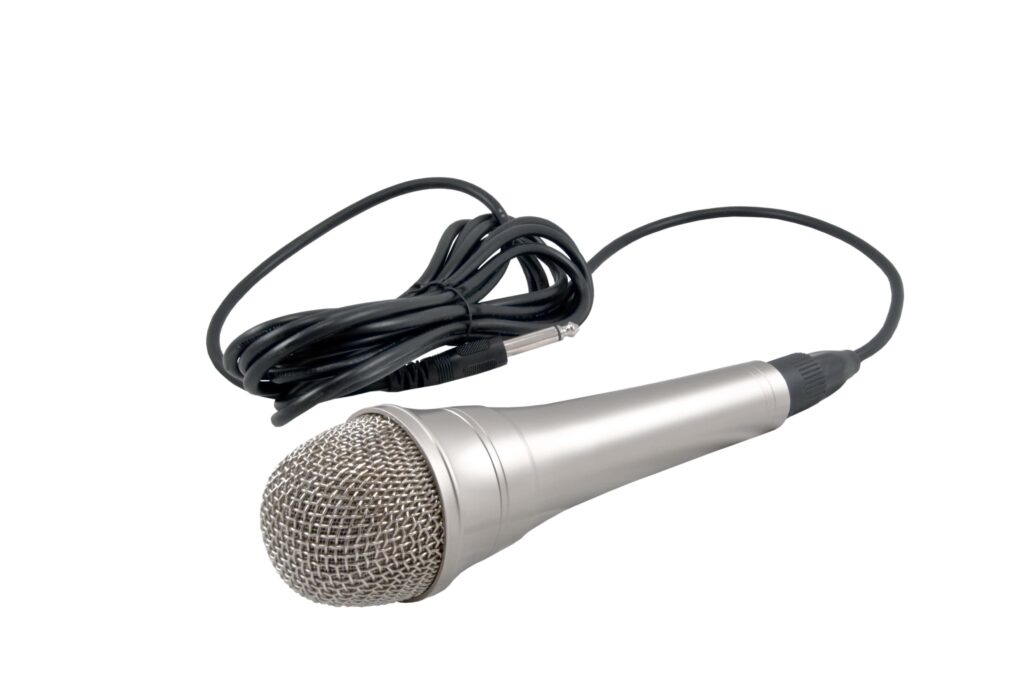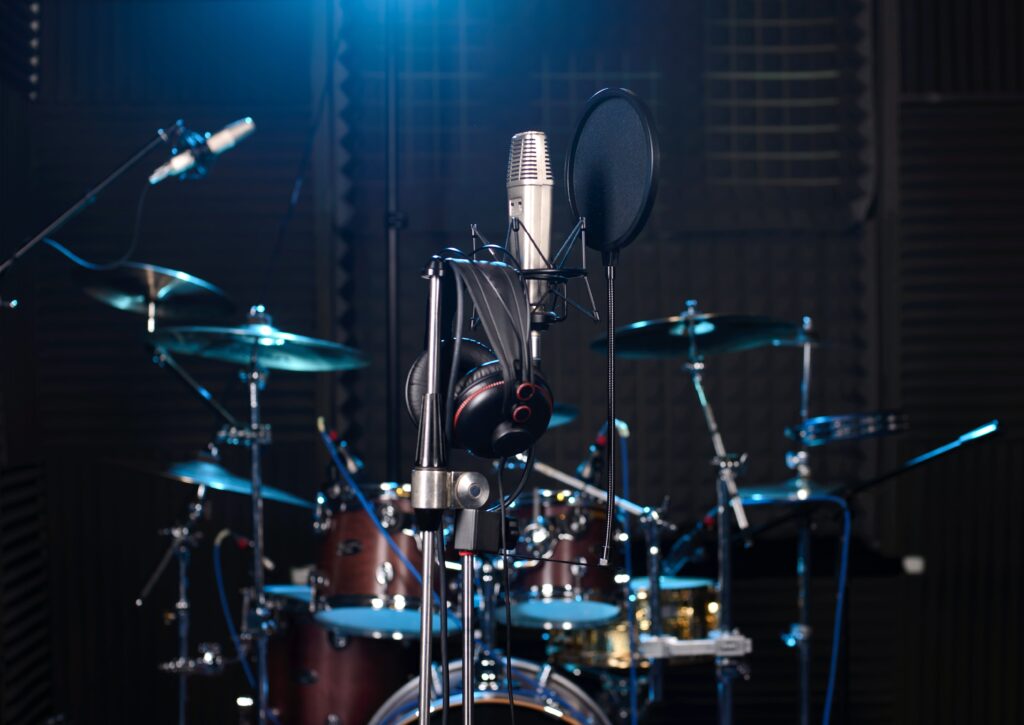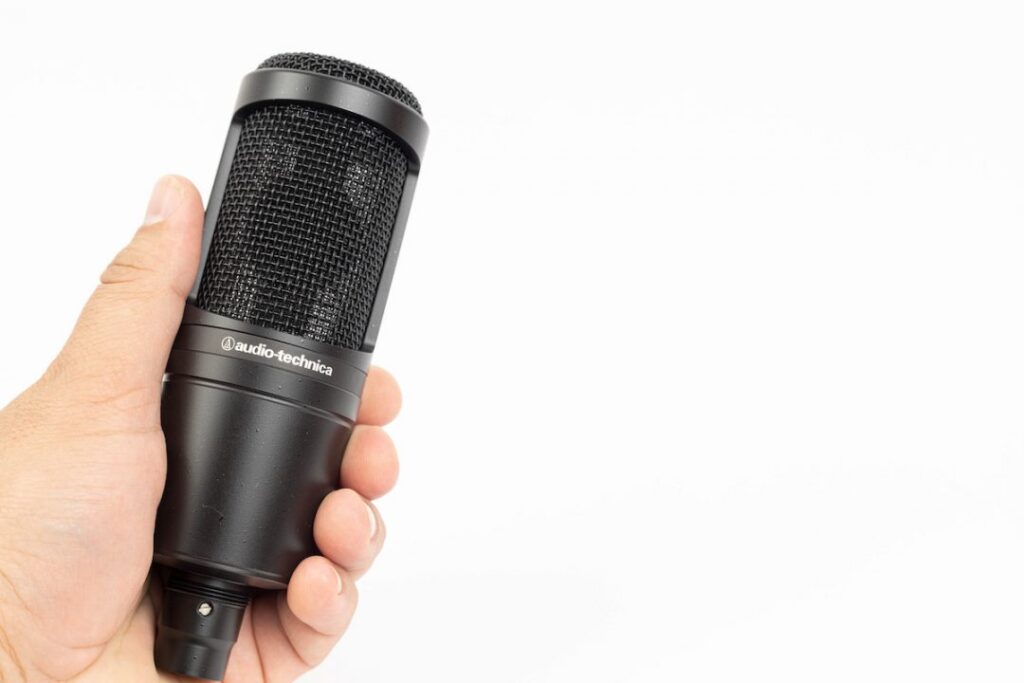- The Birth of Microphones: Explore the invention of the microphone and its initial variations.
- David Edward Hughes’ Contribution: Discuss David Edward Hughes’ development of an early microphone model in 1878.
- The Rise of Vacuum Tube Amplifiers: Highlight the invention of the vacuum tube amplifier in 1915 and its impact on microphone technology.
- The Birth of Condenser Microphones: Introduce Edward Christopher Wente’s condensation microphone in 1916 and its significance.
Beginning in the early 1900s, scientists, inventors, and engineers began experimenting with dynamic microphones, which convert sound into an electric signal. In 1877, Thomas Edison was the first to create a dynamic microphone, but the technique wasn’t practical until the 1920s.
What is a Dynamic microphone?
A dynamic microphone is a transducer audio device that converts sound (mechanical wave energy) into audio (electrical energy) using a moving electrically conductive diaphragm, a permanent magnetic structure, Autotune Microphone recording and the principle of electromagnetic induction. Sound is converted into electrical energy by a dynamic microphone.
Early Development of Microphones
The journey of the dynamic microphones was start in the 19th century when Alexander Graham Bell and Elisha Gray invented the first practical telephones. In the early telephones used carbon microphones, which consisted of carbon granules pressed between two metal plates. Changes in pressure caused by sound waves would alter the electrical resistance of the carbon, converting sound into electrical signals. However, carbon microphones had limitations, including poor frequency response and sensitivity.
Basic Fundamental of Dynamic Microphones
Dynamic microphones Works on the principle of electromagnetic induction. They consist of a diaphragm attached to a coil wire and placed within the magnetic field of a permanent magnet.
When sound waves hit the diaphragm, it moves, causing the attached coil to move within the magnetic field. This movement generates an electrical current in the coil, which is proportional to the sound waves’ amplitude and frequency.
One of the advantages of dynamic microphones is its handeling the high power sound handling ability. They are commonly used for live sound performance reinforcement, recording instruments, and broadcasting due to their ruggedness and reliability
Initial Use in Broadcasting and Entertainment
Dynamic microphones found their initial niche in broadcasting and entertainment due to their durability, reliability, and ability to handle high sound pressure levels. These microphones were essential tools for radio broadcasts, live performances, and recording studios. They played a pivotal role in shaping the audio quality of early radio programs and live shows.
In broadcasting, dynamic microphones offered an advantage by effectively capturing the human voice while minimizing ambient noise and feedback. This made them indispensable for radio announcers, reporters, and performers. They became synonymous with the golden age of radio and the early days of television.
In the entertainment industry, dynamic microphones were used by musicians, singers, and public speakers, allowing them to deliver clear and intelligible performances even in challenging acoustic environments. This made dynamic microphones integral to the development of music and entertainment in the 20th century.
Technological Advancements in Dynamic Microphones
Over the years, dynamic microphones have undergone significant technological advancements in materials, construction, and design, resulting in improved performance and versatility.
Neodymium Magnets
The introduction of neodymium magnets in dynamic microphones significantly enhanced their magnetic field strength. This innovation led to increased sensitivity and efficiency in converting acoustic sound into electrical signals. Neodymium magnets are smaller and lighter than traditional magnets, making microphones more portable.
Improved Diaphragm Materials
Advances in diaphragm materials, such as mylar and other lightweight yet durable substances, have contributed to better frequency response and transient accuracy. These materials also resist moisture and temperature changes, ensuring consistent performance in various conditions.
Internal Shock Mounts
Many modern dynamic microphones incorporate internal shock mounts to reduce mechanical vibrations and handling noise. This feature enhances the microphone’s stability and isolates it from external disturbances, resulting in cleaner recordings.
Those Industries where Microphones are Used
Dynamic microphones have found a diverse range of applications across various industries due to their resilience and suitability in challenging environments. Their reliability and versatility make them indispensable tools in the following sectors
1. Music and Live Performances:
Dynamic microphones are a staple in the music industry, used for amplifying vocals and instruments in live performances. They excel in handling high sound pressure levels on stage, making them ideal for miking guitar amplifiers, drum kits, and vocals. The Shure SM58, for instance, is a legendary choice for vocalists worldwide.
2. Studio Recording:
Dynamic microphones remain relevant in modern studio recording, particularly for specific sound sources. They are favoured for close-miking loud instruments like guitar cabinets and snare drums due to their ability to capture transient details and handle loud volumes.
3. Broadcasting and Podcasting:
Dynamic microphones are crucial in radio broadcasting and podcasting. Their robustness and resistance to handling noise and plosives make them ideal for close-miking announcers, podcast hosts, and interviewees. Models like the Electro-Voice RE20 and the Rode PodMic have gained popularity in the podcasting world.
4. Sound Reinforcement:
In venues, arenas, and conference settings, dynamic microphones are often used for public address systems, presentations, and speeches. Their ability to reject feedback and background noise ensures clear communication in challenging acoustic environments.
5. Industrial and Manufacturing
Dynamic microphones find applications in industrial settings for monitoring and quality control. They are used to detect unusual sounds or vibrations in machinery and production lines, helping to prevent equipment failures and ensure worker safety.
6. Aerospace and Defense
Dynamic microphones are employed in military and aerospace applications for communication in noisy and high-stress environments. They are used in pilot headsets, ground control stations, and communication systems in military vehicles.
7. Telecommunications
Dynamic microphones are integrated into telephone handsets and headsets for clear voice communication in telephony and customer service industries.
Type of Dynamic Microphones
- Hypercardioid Microphone
- Handheld Dynamic Microphone
- Instrument Microphone
- Kick drum Microphone
- Headset Microphone
- Cardioid Microphone
Today, different microphones use different ways to turn the changes in air pressure caused by a sound wave into an electrical signal. The most common are the dynamic microphone, which uses a coil of wire suspended in a magnetic field; the condenser microphone, which uses a vibrating diaphragm as a capacitor plate; and the contact microphone, which uses a crystal made of piezoelectric material. Before a microphone’s signal can be recorded or played back, it must be hooked up to a preamplifier.
Conclusion
The historical journey of dynamic microphones is a testament to the remarkable evolution of audio technology. From their early roots in the late 19th century, dynamic microphones have come a long way to become essential tools in various industries, and they continue to play a very important role in the world of audio technology.
Dynamic microphones trace their origins to the pioneering work of inventors like Emile Berliner, who in 1877, introduced the concept of electromagnetic induction-based microphones. These early designs featured a diaphragm connected to a coil of wire within the magnetic field of a permanent magnet. This groundbreaking principle laid the foundation for dynamic microphones.
However, it was the work of Harry F. Olson at Bell Labs in the 1920s that truly propelled dynamic microphones into the modern era. Olson’s innovations and refinements resulted in the creation of the moving-coil microphone, a design that forms the basis of the dynamic microphones we use today. These early models were used for broadcasting, studio recording, and live sound reinforcement.
Over the years, dynamic microphones have seen significant advancements in materials, construction, and design. Innovations such as neodymium magnets, improved diaphragm materials, and internal shock mounts have led to improved performance, durability, and versatility. These technological enhancements have allowed dynamic microphones to maintain their relevance in an ever-evolving audio landscape.
Today, dynamic microphones find applications across a diverse range of industries. They are celebrated for their resilience and suitability in challenging environments. In the music and entertainment industry, dynamic microphones remain indispensable for live performances, studio recording, and sound reinforcement. Artists and engineers rely on their ability to capture the nuances of vocals and instruments while withstanding high sound pressure levels on stage.
In broadcasting and podcasting, dynamic microphones are the go-to choice for their exceptional noise rejection and durability. These microphones ensure clear and intelligible communication, whether it’s a radio broadcast, a podcast interview, or a live-streamed event. Models like the Shure SM7B and the Electro-Voice RE20 have become iconic in these domains.
Dynamic microphones also find applications beyond the world of entertainment. In industrial and manufacturing settings, they are used for monitoring machinery and ensuring product quality. In the aerospace and defense sectors, they facilitate communication in high-stress environments. In telecommunications, they enable clear voice communication in telephony and customer service industries.
The ongoing relevance of dynamic microphones in today’s rapidly evolving audio landscape cannot be overstated. While condenser microphones and digital technology have expanded the options available to audio professionals, dynamic microphones continue to hold a special place. Their durability, ability to handle high sound pressure levels, and resistance to moisture and dust make them reliable workhorses in challenging conditions.
Moreover, dynamic microphones provide a distinct character to audio recordings, known for their warm and natural sound. This unique sonic signature makes them a preferred choice for certain sound sources and applications.




